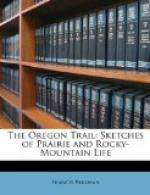We were in all four men with eight animals; for besides the spare horses led by Shaw and myself, an additional mule was driven along with us as a reserve in case of accident.
After this summing up of our forces, it may not be amiss to glance at the characters of the two men who accompanied us.
Delorier was a Canadian, with all the characteristics of the true Jean Baptiste. Neither fatigue, exposure, nor hard labor could ever impair his cheerfulness and gayety, or his obsequious politeness to his bourgeois; and when night came he would sit down by the fire, smoke his pipe, and tell stories with the utmost contentment. In fact, the prairie was his congenial element. Henry Chatillon was of a different stamp. When we were at St. Louis, several gentlemen of the Fur Company had kindly offered to procure for us a hunter and guide suited for our purposes, and on coming one afternoon to the office, we found there a tall and exceedingly well-dressed man with a face so open and frank that it attracted our notice at once. We were surprised at being told that it was he who wished to guide us to the mountains. He was born in a little French town near St. Louis, and from the age of fifteen years had been constantly in the neighborhood of the Rocky Mountains, employed for the most part by the Company to supply their forts with buffalo meat. As a hunter he had but one rival in the whole region, a man named Cimoneau, with whom, to the honor of both of them, he was on terms of the closest friendship. He had arrived at St. Louis the day before, from the mountains, where he had remained for four years; and he now only asked to go and spend a day with his mother before setting out on another expedition. His age was about thirty; he was six feet high, and very powerfully and gracefully molded. The prairies had been his school; he could neither read nor write, but he had a natural refinement and delicacy of mind such as is rarely found, even in women. His manly face was a perfect mirror of uprightness, simplicity,




